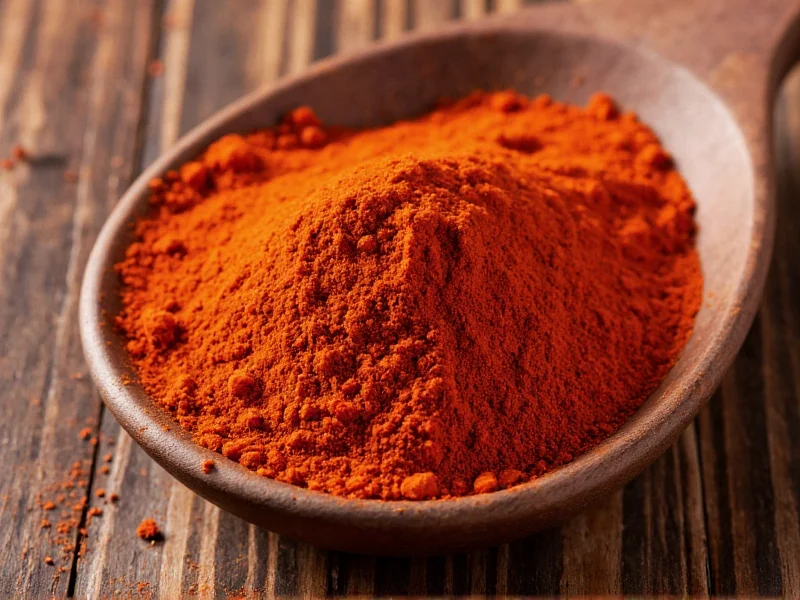When exploring the difference between smoked paprika and cayenne, it's essential to recognize how these distinct spices impact your cooking. Many home chefs mistakenly treat them as interchangeable, potentially ruining carefully crafted dishes. Let's examine their unique characteristics to help you make informed seasoning decisions.
Flavor Profiles: Complexity vs. Pure Heat
Smoked paprika (pimentón) undergoes a traditional smoking process using oak or other hardwoods, creating a complex flavor profile with notes of:
- Earthy smokiness
- Subtle sweetness
- Woody undertones
- Mild fruitiness
Conversely, cayenne pepper provides a direct, intense heat with minimal complexity. Made from dried, ground cayenne peppers, it delivers:
- Sharp, immediate heat
- Limited flavor dimension
- Simple peppery notes
- No smokiness whatsoever
Heat Level Comparison
Understanding smoked paprika vs cayenne heat level is critical for recipe success:
| Spice | Scoville Heat Units | Heat Perception | Common Culinary Use |
|---|---|---|---|
| Smoked Paprika (Sweet) | 100-500 SHU | Mild, barely detectable heat | Coloring, subtle smokiness |
| Smoked Paprika (Medium) | 2,500-5,000 SHU | Moderate warmth | Balanced flavor and color |
| Smoked Paprika (Hot) | 5,000-8,000 SHU | Noticeable heat | Spicy applications with smokiness |
| Cayenne Pepper | 30,000-50,000 SHU | Intense, immediate burn | Direct heat addition |
This significant heat disparity explains why can I substitute smoked paprika for cayenne requires careful consideration. Using equal amounts would dramatically alter your dish's flavor balance.
Production Methods and Origins
Traditional smoked paprika originates primarily from Spain and Hungary, where specific pepper varieties are slowly smoked over wood fires for days. This smoking process creates its signature flavor. The three main varieties include:
- Dulce (sweet) - Mild and deeply colored
- Agridulce (bittersweet) - Medium heat
- Picante (hot) - Noticeable heat with smokiness
Cayenne pepper, by contrast, comes from grinding dried cayenne peppers without any smoking process. Originating from Central and South America, it's valued purely for its heat rather than complex flavor development.
When to Use Each Spice
Choosing between these spices depends on your recipe's requirements:
Reach for Smoked Paprika When:
- You want to add smoky depth without overwhelming heat
- Creating Spanish, Hungarian, or barbecue-inspired dishes
- Need vibrant red color without intense spiciness
- Building complex flavor layers in stews, rubs, or sauces
Choose Cayenne Pepper When:
- You need straightforward, intense heat
- Boosting spiciness in sauces, curries, or hot blends
- Creating Cajun or Creole seasoning mixes
- Adding heat without altering flavor profile significantly
Substitution Guidelines
Understanding what's the difference between paprika and cayenne pepper helps with substitutions:
Replacing cayenne with smoked paprika: Use 1½-2 teaspoons smoked paprika for every ¼ teaspoon cayenne. Be aware this adds smokiness that may alter your dish's intended flavor profile.
Replacing smoked paprika with cayenne: Use ⅛ teaspoon cayenne plus 1 teaspoon sweet paprika for every 1 teaspoon smoked paprika. This approximates color while adding minimal smokiness.
For authentic Spanish dishes like paella or Hungarian goulash, substitutions often compromise traditional flavor profiles. When precision matters, use the specified spice.
Common Misconceptions
Many home cooks believe is smoked paprika hotter than cayenne, but this is inaccurate. Even hot smoked paprika (8,000 SHU) is significantly milder than cayenne (30,000-50,000 SHU). Another misconception is that all paprika varieties offer smokiness—only specifically labeled "smoked" paprika contains this characteristic.
Storage and Freshness Tips
Both spices lose potency over time. Store in airtight containers away from light and heat. Smoked paprika typically maintains quality for 1-2 years, while cayenne remains potent for 2-3 years. Properly stored, they should retain vibrant color and strong aroma. Dull color or weak scent indicates diminished quality.
Frequently Asked Questions
Can I use smoked paprika instead of cayenne in chili?
Yes, but with significant adjustments. For every ¼ teaspoon cayenne, use 1½-2 teaspoons smoked paprika. Be aware this substitution adds smokiness that changes the traditional chili profile. For authentic heat without flavor alteration, consider using regular paprika with a small amount of cayenne.
Which is healthier: smoked paprika or cayenne?
Both offer health benefits but in different ways. Cayenne contains higher capsaicin levels, potentially boosting metabolism and reducing inflammation. Smoked paprika provides antioxidants from the smoking process and retains vitamin content from the peppers. Neither is definitively "healthier"—they serve different nutritional purposes.
Why does my smoked paprika taste bitter?
Bitterness in smoked paprika usually indicates either expired product or excessive heat during cooking. Smoked paprika's delicate compounds burn easily—never add it directly to high-heat pans. Instead, incorporate it during the last few minutes of cooking or bloom in warm oil at low temperature to preserve its nuanced flavor.
Does smoked paprika contain actual smoke?
Authentic smoked paprika gains its flavor through traditional smoking processes where peppers are dried over wood fires for 1-2 weeks. This imparts genuine smoky compounds into the peppers. Some cheaper alternatives use liquid smoke for artificial flavoring, but traditional varieties contain naturally absorbed smoke elements from the drying process.
Can I make my own smoked paprika?
Creating authentic smoked paprika at home is challenging without proper smoking equipment. The traditional process requires specific pepper varieties smoked at precise temperatures for days. For home cooks, the closest approximation involves smoking fresh peppers in a smoker, then drying and grinding them. However, commercial products generally offer more consistent results for most cooking applications.











 浙公网安备
33010002000092号
浙公网安备
33010002000092号 浙B2-20120091-4
浙B2-20120091-4